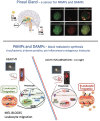Possible Role of Pineal and Extra-Pineal Melatonin in Surveillance, Immunity, and First-Line Defense
- PMID: 34830026
- PMCID: PMC8620487
- DOI: 10.3390/ijms222212143
Possible Role of Pineal and Extra-Pineal Melatonin in Surveillance, Immunity, and First-Line Defense
Abstract
Melatonin is a highly conserved molecule found in prokaryotes and eukaryotes that acts as the darkness hormone, translating environmental lighting to the whole body, and as a moderator of innate and acquired defense, migration, and cell proliferation processes. This review evaluates the importance of pineal activity in monitoring PAMPs and DAMPs and in mounting an inflammatory response or innate immune response. Activation of the immune-pineal axis, which coordinates the pro-and anti-inflammatory phases of an innate immune response, is described. PAMPs and DAMPs promote the immediate suppression of melatonin production by the pineal gland, which allows leukocyte migration. Monocyte-derived macrophages, important phagocytes of microbes, and cellular debris produce melatonin locally and thereby initiate the anti-inflammatory phase of the acute inflammatory response. The role of locally produced melatonin in organs that directly contact the external environment, such as the skin and the gastrointestinal and respiratory tracts, is also discussed. In this context, as resident macrophages are self-renewing cells, we explore evidence indicating that, besides avoiding overreaction of the immune system, extra-pineal melatonin has a fundamental role in the homeostasis of organs and tissues.
Keywords: first-line defense; immune–pineal axis; resident macrophages.
Conflict of interest statement
The authors declare no conflict of interest.
Figures



Similar articles
-
Immune-pineal axis - acute inflammatory responses coordinate melatonin synthesis by pinealocytes and phagocytes.Br J Pharmacol. 2018 Aug;175(16):3239-3250. doi: 10.1111/bph.14083. Epub 2017 Dec 15. Br J Pharmacol. 2018. PMID: 29105727 Free PMC article. Review.
-
The immune-pineal axis: a shuttle between endocrine and paracrine melatonin sources.Neuroimmunomodulation. 2007;14(3-4):126-33. doi: 10.1159/000110635. Epub 2007 Dec 5. Neuroimmunomodulation. 2007. PMID: 18073503 Review.
-
Glia-pinealocyte network: the paracrine modulation of melatonin synthesis by tumor necrosis factor (TNF).PLoS One. 2012;7(7):e40142. doi: 10.1371/journal.pone.0040142. Epub 2012 Jul 2. PLoS One. 2012. PMID: 22768337 Free PMC article.
-
The concept of the immune-pineal axis tested in patients undergoing an abdominal hysterectomy.Neuroimmunomodulation. 2013;20(4):205-12. doi: 10.1159/000347160. Epub 2013 May 8. Neuroimmunomodulation. 2013. PMID: 23689687
-
Bidirectional communication between the pineal gland and the immune system.Can J Physiol Pharmacol. 2003 Apr;81(4):342-9. doi: 10.1139/y03-026. Can J Physiol Pharmacol. 2003. PMID: 12769226
Cited by
-
The role of melatonin in the development of postmenopausal osteoporosis.Front Pharmacol. 2022 Oct 7;13:975181. doi: 10.3389/fphar.2022.975181. eCollection 2022. Front Pharmacol. 2022. PMID: 36278157 Free PMC article. Review.
-
Therapeutic Effects of Melatonin in the Regulation of Ferroptosis: A Review of Current Evidence.Curr Drug Targets. 2024;25(8):543-557. doi: 10.2174/0113894501284110240426074746. Curr Drug Targets. 2024. PMID: 38706348 Review.
-
Blunted Melatonin Circadian Rhythm in Parkinson's Disease: Express Bewilderment.Neurotox Res. 2024 Aug 23;42(5):38. doi: 10.1007/s12640-024-00716-0. Neurotox Res. 2024. PMID: 39177895 Review.
-
Looking beyond Self-Protection: The Eyes Instruct Systemic Immune Tolerance Early in Life.Brain Sci. 2023 Aug 30;13(9):1261. doi: 10.3390/brainsci13091261. Brain Sci. 2023. PMID: 37759864 Free PMC article.
-
Melatonin's Impact on Wound Healing.Antioxidants (Basel). 2024 Oct 2;13(10):1197. doi: 10.3390/antiox13101197. Antioxidants (Basel). 2024. PMID: 39456451 Free PMC article. Review.
References
-
- Cannon W.B. Bodily Changes in Pain, Hunger, Fear and Rage: An Account of Recent Researches into the Function of Emotional Excitement. D Appleton & Company; New York, NY, USA: 1915. - DOI
-
- Brown J.W., Churchill R.V. Fourier Series and Boundary Value Problems. 8th ed. McGraw-Hill; New York, NY, USA: 2012.
Publication types
MeSH terms
Substances
Grants and funding
LinkOut - more resources
Full Text Sources

